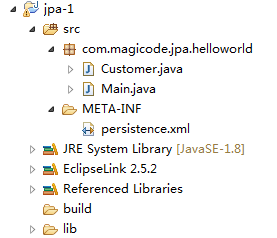这一节写一个JPA的HelloWorld来体验一下。
一、建立工程
按照 1、创建一个JPA project(解决“at least one user library must be selected”问题)中说的步骤建立一个JPA project。创建过程极其简单,就是 New → JPA project 就可以了。当然,如果在创建的过程中出现了at least one user library must be selected 问题,而user library中又没有选项的时候可以参看第一节后面的解决方案(如果想给动态web工程创建JPA环境也参照这一节)。然后在工程中创建一个lib目录用于放置第三方jar包。工程结构如下:

二、添加必须的jar包
JPA是一个标准,其有很多种实现,如Hibernate,OpenJPA,TopLink等。之前学习过Hibernate,那么就用Hibernate的实现来进行学习。
要用到的jar包有:
①、hibernate-release-4.3.10.Finallib equired 文件夹下的所有jar包
②、hibernate-release-4.3.10.Finallibjpa 文件夹下的所有jar包
③、MySQL 的jdbc驱动包 mysql-connector-java-5.1.7-bin.jar
三、创建实体(entity)类Customer.java
在创建实体类的时候会用到一些注解,这些注解在下一节进行讲解。不过这些注解的作用很容易理解。下面是Customer的代码:
1 package com.magicode.jpa.helloworld; 2 3 import javax.persistence.Column; 4 import javax.persistence.Entity; 5 import javax.persistence.GeneratedValue; 6 import javax.persistence.GenerationType; 7 import javax.persistence.Id; 8 import javax.persistence.Table; 9 10 /** 11 * @Entity 用于注明该类是一个实体类 12 * @Table(name="t_customer") 表明该实体类映射到数据库的 t_customer 表 13 */ 14 @Table(name="t_customer") 15 @Entity 16 public class Customer { 17 18 private Integer id; 19 private String lastName; 20 21 private String email; 22 private int age; 23 24 /** 25 * @GeneratedValue(strategy=GenerationType.AUTO) 指明主键生成策略为AUTO 26 * @Id 表明实体类的主键 27 */ 28 @GeneratedValue(strategy=GenerationType.AUTO) 29 @Id 30 public Integer getId() { 31 return id; 32 } 33 34 /** 35 * @Column 指明lastName属性映射到表的 LAST_NAME 列中 36 * 同时还可以指定其长度、能否为null等数据限定条件 37 */ 38 @Column(name="LAST_NAME", length=50, nullable=false) 39 public String getLastName() { 40 return lastName; 41 } 42 43 public String getEmail() { 44 return email; 45 } 46 47 public int getAge() { 48 return age; 49 } 50 51 public void setId(Integer id) { 52 this.id = id; 53 } 54 55 public void setLastName(String lastName) { 56 this.lastName = lastName; 57 } 58 59 public void setEmail(String email) { 60 this.email = email; 61 } 62 63 public void setAge(int age) { 64 this.age = age; 65 } 66 67 }
四、修改配置文件persistence.xml
1 <?xml version="1.0" encoding="UTF-8"?> 2 <persistence version="2.0" 3 xmlns="http://java.sun.com/xml/ns/persistence" xmlns:xsi="http://www.w3.org/2001/XMLSchema-instance" 4 xsi:schemaLocation="http://java.sun.com/xml/ns/persistence http://java.sun.com/xml/ns/persistence/persistence_2_0.xsd"> 5 6 <!-- 注意这里的 persistence-unit标签的name属性值,main函数中会用到它 --> 7 <persistence-unit name="jpa-1" transaction-type="RESOURCE_LOCAL"> 8 9 <!-- 配置使用什么样的ORM产品作为JPA的实现 10 1、实际上配置的是 javax.persistence.spi.PersistenceProvider 接口的实现类 11 2、若JPA项目中只有一个JPA的实现产品,则可以不配置provider节点 12 --> 13 <provider>org.hibernate.jpa.HibernatePersistenceProvider</provider> 14 15 <!-- 添加持久化类 --> 16 <class>com.magicode.jpa.helloworld.Customer</class> 17 18 <properties> 19 <!-- 连接数据库的基本信息 --> 20 <property name="javax.persistence.jdbc.driver" value="com.mysql.jdbc.Driver" /> 21 <property name="javax.persistence.jdbc.url" value="jdbc:mysql:///jpa" /> 22 <property name="javax.persistence.jdbc.user" value="root" /> 23 <property name="javax.persistence.jdbc.password" value="tiger123" /> 24 25 <!-- 配置JPA实现产品的基本属性:配置Hibernate的基本属性 --> 26 <property name="hibernate.format_sql" value="true" /> 27 <property name="hibernate.show_sql" value="true" /> 28 <property name="hibernate.hbm2ddl.auto" value="update" /> 29 30 </properties> 31 32 </persistence-unit> 33 </persistence>
五、编写测试主函数Main.java。一共分为7个步骤进行:
1 package com.magicode.jpa.helloworld; 2 3 import javax.persistence.EntityManager; 4 import javax.persistence.EntityManagerFactory; 5 import javax.persistence.EntityTransaction; 6 import javax.persistence.Persistence; 7 8 public class Main { 9 10 public static void main(String[] args) { 11 12 /* 13 * 1、获取EntityManagerFactory实例 14 * 利用Persistence类的静态方法,结合persistence.xml中 15 * persistence-unit标签的name属性值得到 16 */ 17 EntityManagerFactory emf = 18 Persistence.createEntityManagerFactory("jpa-1"); 19 20 // 2、获取EntityManager实例 21 EntityManager em = emf.createEntityManager(); 22 23 // 3、开启事物 24 EntityTransaction transaction = em.getTransaction(); 25 transaction.begin(); 26 27 // 4、调用EntityManager的persist方法完成持久化过程 28 Customer customer = new Customer(); 29 customer.setAge(9); 30 customer.setEmail("Tom@163.com"); 31 customer.setLastName("Tom"); 32 em.persist(customer); 33 34 // 5、提交事物 35 transaction.commit(); 36 // 6、关闭EntityManager 37 em.close(); 38 // 7、关闭EntityManagerFactory 39 emf.close(); 40 41 } 42 43 }
可以看出:EntityManagerFactory 的功能类似于 Hibernate 中的 SessionFactory; EntityManager 的功能类似于 Hibernate 中的Session。
六、运行结果
运行mian方法,JPA就会自动的连接到数据库jpa中,同时创建一个t_customer数据表。有一个需要注意的地方:需要手动创建一个数据库jpa。JPA会自动帮我们创建数据表,但是它不会自动创建数据库。
main方法运行以后创建的数据表t_customer,并把一个Customer对象进行了持久化:
